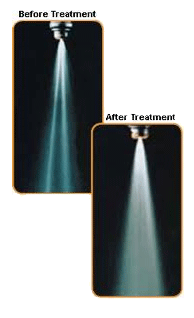PRODUCT IDENTIFICATION
| PRODUCT NAME | EFFECTIVE DATE | PRODUCT CODE |
| Wynn's Fuel Injector Cleaner | 3-22-06 | 65221A |
| CHEMICAL NAME | | CAS NUMBER |
| N/A | | N/A |
HAZARDOUS INGREDIENTS
| COMMON NAME | CHEMICAL NAME | CAS NO. | % | OSHA PEL | ACGIH TLV-TWA |
| Petroleum Hydrocarbon | Petroleum Distillate | 68334-30-5 | 90-95 | 5 mg/m³ | 5 mg/m³ |
| Aromatic Solvent | Light Aromatic Solvent Naphtha | 64742-95-6 | 1-5 | Not Established | Not Established
|
Contains no other ingredients now known to be hazardous as defined by OSHA 29CFR 1910.1000(z) and 29CFR 1910.1200.
PHYSICAL DATA
These data are approximate or typical values and should not be used as precise specifications. Unless otherwise noted values are at 20°C(68°F) and 760 mmHg (1 atm).
| Boiling Point/Range |
405°F(>207°C) |
Freeze Point |
N/D |
| Specific Gravity (H20=1) @ 15.6°C |
0.837 |
Vapor Pressure (mm Hg) |
> 1 |
| Vapor Density (Air =1) |
>1 |
Solubility in Water (%) |
Negligible |
| % Volatiles by Volume |
N/D |
Evaporation Rate (Butyl Acetate = 1) |
>1 |
| pH (as is) |
N/A |
pH (dilute) @ % |
N/A |
| Appearance |
Clear Amber Liquid |
Odor |
Petroleum Distillate |
N/D - Not Determined
< = Less Than
N/A - Not Applicable
> = Greater Than
FIRE AND EXPLOSION HAZARD DATA
Flash Point 148°F(64°C) Method Pensky - Martens Closed Cup ASTM D-93
Hazard Class Identification
Flammability 2
Health 2
Reactivity 0
Other -
Hazard Code
0 - Least (insignificant)
1 - Slight
2 - Moderate
3 - High
4 - Extreme
Extinguishing Media
Dry Chemicals, carbon dioxide, water spray, foam.
Special Fire Fighting Procedures
Use water only to cool containers. Fire fighters wear self contained breathing apparatus when hydrocarbons are
involved in fire.
Unusual Fire and Explosion Hazards
Containers exposed to heat from fire should be cooled with water to prevent vapor pressure build up.
REACTIVITY DATA
Stability
Stable.
Conditions to Avoid
Sources of heat or flame.
Materials to Avoid
Strong oxidizing agents.
Hazardous Decomposition or Combustion Products
Thermal decomposition may produce oxides of carbon, nitrogen and sulfur.
Hazardous Polymerization (conditions) will not occur
HEALTH HAZARDS/ROUTES OF ENTRY
Signs, Symptoms and Effects of Overexposure
Ingestion (swallowing) May be harmful if swallowed. May cause irritation to the digestive tract.
Skin Contact May absorb on prolonged exposure. May cause irritation, defatting, burning, redness, stinging of the skin.
Eye Contact May cause irritation, burning, redness, blurred vision, swelling and corneal damage.
Inhalation (breathing) No effect.
Other Effects of Prolonged/Repeated Overexposure
This material has not been identified as a carcinogen by NTP, IARC or OSHA.
EMERGENCY AND FIRST AID PROCEDURES
Ingestion (swallowing) Ingestion of this material may cause vomiting. Aspiration into the lungs during ingestion or
vomiting can result in severe pulmonary damage.
Skin Contact Single contact, moderate irritation to skin. Prolonged or repeated contact can result in
defatting and drying of skin. May cause mild sensitization.
Eye Contact May cause mild to moderate irritation to eyes.
Inhalation (breathing) Inhalation of vapors or mist may cause mild irritation to the upper respiratory tract. High
level exposure may result in central nervous system depression.
Comments NOTE TO PHYSICIANS: Treatment should be based on symptoms and clinical condition.
SPILL OR RELEASE CONTROL PROCEDURES
Steps to be taken in case material is released or spilled
Isolate area and restrict entry. Combustible liquid. Eliminate all sources of ignition. Use absorbent, sand or clay.
Shovel into containers. Remove out of doors. Prevent liquid from entering sewers and water ways.
Waste Disposal Method
Dispose of in accordance with Federal, State and Local regulations.
EPA Reportable Quantity (RQ), 40CFR302 (CERCLA104)
N/A
EPA Toxic Chemical Release Reporting, 40CFR372(SARA313)
| Chemical | CAS NO. | % in Product |
| N/A | N/A | N/A |
HANDLING AND STORAGE
Handling and Storage Precautions
CAUTION: Contains petroleum distillate. Avoid skin and eye contact. Combustible. Keep away from heat and
sparks. Keep containers closed. DO NOT store opened containers. Use entire contents.
Other Precautions
KEEP OUT OF REACH OF CHILDREN!
PERSONAL PROTECTION - EXPOSURE CONTROL
Ventilation
Provide adequate general or local ventilation to maintain concentrations below TLV/PEL limits.
Respiratory Protection
None normally required. If vapors exceed TLV/PEL values, use a NIOSH approved respirator.
Eye Protection
Safety glasses.
Protective Gloves
Impervious gloves.
Other Protective Clothing or Equipment
None.
Work/Hygienic Practices
Personal cleanliness is always appropriate. Frequent washing minimizes chances of inadvertent exposure.
TRANSPORTATION INFORMATION
Department of Transportation (DOT) Classification
| | Flammable Liquid | | Corrosive |
| | Flammable Solid | | Non Flammable Gas |
| | Flammable Gas | | Non Hazardous by DOT |
| | Combustible Liquid | | Other |
DOT Proper Shipping Name
N/A (Not DOT regulated in quantities at or less than 119 gallons.)
DOT ID Number
N/A
Packing Group
N/A
DOCUMENTATION
Product Code No.: 5221A
Previous Code No.: 65221A
Issue Date: 03-24-06
Prior Date: 09-01-05
This information is, to the best of our knowledge and belief, accurate and reliable as of the date compiled. However, no representation, warranty or guarantee is made as to its accuracy, reliability or completeness. It is the user's responsibility to satisfy himself as to the suitability and completeness of such information for his own particular use.
|







 Wynn's Fuel Injector Cleaner contains concentrated detergents and dispersants guaranteed to clean dirty injectors with just one usage. Fuel injector cleaner is compatible with catalytic converters, oxygen sensors, and all other new fuel system components.
Wynn's Fuel Injector Cleaner contains concentrated detergents and dispersants guaranteed to clean dirty injectors with just one usage. Fuel injector cleaner is compatible with catalytic converters, oxygen sensors, and all other new fuel system components.